************************************************************
|
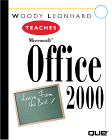

|
Woody Leonhard Teaches Microsoft Office
2000
(the Best Advice from the Best Authors)
Woody Leonhard knows an awful lot about using Microsoft
Office. He's been writing about the popular suite through several of its
releases and publishes a highly regarded newsletter in which he disseminates
hints and tips for its users. In Woody Leonhard Teaches Microsoft Office
2000 , the expert holds forth on how to get your work done with Microsoft's
flagship productivity package.
Leonhard covers the major Office 2000 members -- Word, Excel, Outlook,
and PowerPoint -- but neglects Access, FrontPage, and the other programs
that ship with the higher-end variants of Office. In his coverage of the
four biggies, he explains how to get things done with the essential pieces
of the programs before taking on more obscure features. Leonhard's advice
is rock-solid and to the point. If the author thinks something about Office
is poorly designed or hard to use, he'll let you -- and Microsoft -- know,
and then he'll show you the best way to get around the sticking point.
|


|
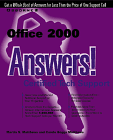

|
Office 2000 Answers! (Answers Series)
The problem with a lot of books about Microsoft Office is
that they let the software dictate their structure. This approach leads
to books that are comprehensive in scope but deathly boring to read. The
authors of Office 2000 Answers! know that books are for people and have
organized their material around the questions Office users have.
For instance, you may have encountered problems with Word "helpfully"
converting paragraphs into list formats when you don't want a list at
all. The authors provide a quick statement of this problem in question
form--in plain English, so that it's easy to recognize as the problem
that's troubling you--and then offer two speedy solutions. Among the questions
and answers, they've inserted informational sidebars that help you decode
jargon and learn about features you may not have seen.
When searching for a particular answer in this book, you
may find it necessary to do some browsing--the index doesn't always lead
you to the relevant page immediately, unless you know the official Office
terms for what you want to read about. Some readers may also find Office
2000 Answers! a bit text-heavy--more screen shots would be helpful in
this book.
|
************************************************************
|
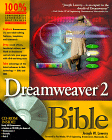


|
Dreamweaver 2 Bible
This comprehensive guide to Macromedia Dreamweaver 2 for
Mac and Windows serves as both an introductory aid for beginners and a
useful reference tool for more experienced users. Lowery does it all:
he explains features and technologies fully, throws in lots of usage tips
and cross-references, and offers screen shots and step-by-step projects.
Lowery begins by explaining Dreamweaver, the current HTML standards, and
new features such as dynamic styles and JavaScript behaviors. He provides
a tour of the interface and helps you set your preferences, starting you
off in the planning and creation of your first site. Later he goes into
more detail about HTML, showing how to use Common Gateway Interface (CGI)
programs, plug-ins, ActiveX, Java applets and scripts, and VBScript. (DHTML
gets its own section too.) There's a series of explanations on specific
Dreamweaver capabilities, from creating objects to customizing behaviors
and tags.
General interest Internet topics get their due, and the book covers multimedia
elements, including how to add video, audio, and Shockwave movies to your
Web page. For larger-scale Web sites, the sections on Cascading Style
Sheets and XML will be useful, and information on dynamic databases and
e-commerce issues wrap the book up nicely.
The appendices offer primers on the HTML editors BBEdit and HomeSite --
advanced HTML editors for Mac and Windows users (respectively)--and on
Dreamweaver Attain, a companion Dreamweaver program that helps you create
instructional Web sites. The companion CD-ROM includes demos of Macromedia's
Dreamweaver , Fireworks, and Flash 3; sample code used in the book; and
Dreamweaver behaviors, objects, commands, style sheets, and inspectors.
|
************************************************************
|


|
Special Edition Using Microsoft Office
2000
Are you a power user? Special Edition: Using Microsoft
Office 2000 has what you're looking for; it'll let you open up the
hood and get your hands dirty tuning Office to run your way.
In addition to comprehensive reference material covering all of the Office
programs -- even Visual Basic for Applications -- you'll find a host of
secrets, hidden features, and "hacks" you'll see nowhere else. Be warned:
some of these tricks are for experienced users only. (One false move in
the Windows Registry and you might find yourself looking at a reinstallation!)
Don't be intimidated, though -- even the timid will find Special Edition
a gold mine of information and resources.
Great indexing lets you find what you need quickly, from absolute cell
references to zooming, and the clear text and graphics will help you solve
any problem -- even ones you didn't know you had. The book comes with
a CD-ROM containing Woody's Office Power Pack (a great set of Office utilities);
the complete, searchable text of the book; and additional material covering
Word, Excel, PowerPoint, and a bundle of cool third-party software that'll
keep you busy for hours. If you've mastered the basics and want to improve
your Office knowledge, let the professionals show you the way with Special
Edition Using Microsoft Office 2000.
|
************************************************************
|
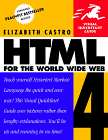

|
HTML 4 for the World Wide Web: Visual
QuickStart Guide
Ask any burgeoning Webpage author what they want in an HTML
guide, and the list would go something like this: concise, informative,
plenty of examples, a little bit of fun without being too cute. Elizabeth
Castro's HTML for the World Wide Web is that dream guide to learning
this Web language.
Unlike other books that lumber along feeding the reader arcane details,
Castro's book keeps to the basics. You'll still learn everything you need
to create a great site (where to start off, how to nest tables, how to
add in video), but you won't feel overwhelmed by the process. The book
is clearly referenced and, in typically concise Peachpit Press style,
full of deceptively simple bullet lists of things to do. On the other
side of the split page are screen shots, illustrations, or other examples
to highlight the steps the reader needs to take to create desired effects.
The book concludes with a listing of special symbols, a color chart, and
a well-devised index of all the goodies contained in this slim -- but
comprehensive -- book
|
************************************************************
|
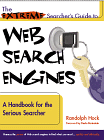

|
The Extreme Searcher's Guide to Web
Search Engines :
A Handbook for the Serious Searcher
Everyone knows how to call up a search site, tap in some
keywords, and hope for something relevant. But to get valuable and speedy
results from Web search engines, you need some advanced knowledge. The
Extreme Searcher's Guide to Web Search Engines tells you what you
need to know.
This book shows you how to assemble high-quality queries on major search
sites. In addition to providing a general tutorial on composing Boolean
searches -- that's all the AND, OR, and NOT stuff -- Randolph Hock shows
you how to use each site's special search terms and characters. He explains
how to do proximity searches on Lycos, for example, and how to limit a
HotBot search to information no more than a week old.
If you're publishing information on a Web site and want to increase its
chances of coming up in search results, be sure to check out Hock's information
on how documents get pulled into the engines' databases and how they're
indexed. Documented sites include AltaVista, Excite, InfoSeek, Lycos,
Yahoo, and others. Hock doesn't pay enough attention to searches for nontext
media -- a search for MP3 files and clip art would have been helpful.
Coverage of non-U.S. search tools is lacking as well. But what's here
satisfies most needs.
|
************************************************************
|




|
300 Incredible Things for Kids on the
Internet
Parents hear all the time about what a great resource the
Internet is, but it's often tough to know where to start. Searching for
information to help with homework often yields more garbage than useful
material, and there's always the risk of stumbling across something offensive
while online. 300 Incredible Things for Kids on the Internet provides
300 starting points for parents and kids who want to explore the Internet
together, safely and constructively.
Essentially, this is a collection of Web addresses, with little commentary,
that you can visit with your browser. The sites cover a considerable range
of topics from general-reference sites (including dictionaries, encyclopedias,
and almanacs) to specialized sites (literature, space exploration, science
projects, dinosaurs, pets, history -- you name it). Everything's screened
for kid-suitability, though the content of the various sites appeals to
different age groups (say, from preschool through junior high).
Plus, Leebow includes a selection of parental-interest sites. These deal
with parenting advice, education issues, health, and safety. These sites
also address Internet issues, including objectionable content and -- for
those parents who need to catch up to their kids' skill level -- the basics
of Web surfing.
|
************************************************************
|


|
Windows for Mac Users
You have a Mac; you love your Mac. But your job requires
you to work with a computer that runs Microsoft Windows 95/98 or Windows
NT 4. This unfortunate circumstance means you need to acquire some special
skills -- the least among them being an ability to cope with Windows'
usage that varies greatly from that of the Mac. Windows for Mac Users
will show you how to make the transition and where you will need to look
for the differences.
The book uses Mac terminology to explain how Windows operates. If you're
wondering what the System folder looks like on a Windows 98 machine or
how to create an alias under Windows NT, Baron and Williams -- unabashed
Mac fans -- have answers for you.
They also have information on why closing a document and quitting an application
are different operations under Windows. They even cover TweakUI -- a downloadable
utility -- as a means of fixing some of Windows' most annoying traits.
Unfortunately, the authors sometimes resort too quickly to the "that's
beyond the scope of this book" excuse...
Windows for Mac Users also provides information for Mac users who
need to share files and other information with Windows users. While their
information on color palettes and filename extensions is excellent, they
leave out detailed information on networking Macs and PCs together. Nonetheless,
Mac users who are out of their element will find this book helpful.
|
************************************************************
|
|
************************************************************
|
Free website animations ¦ Affiliate programs ¦ Chat Room Resources
|



















